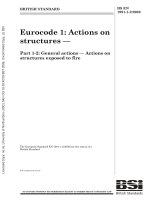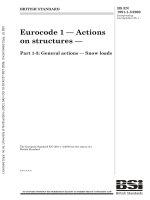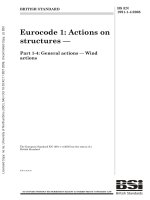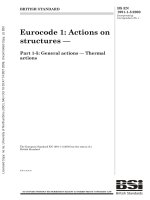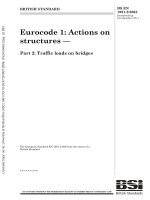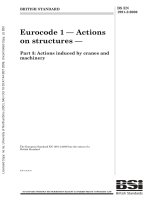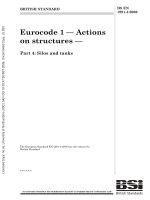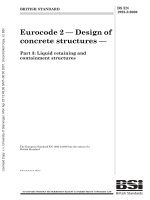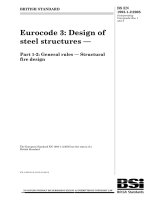Bsi bs au 152 1970 (2011)
Bạn đang xem bản rút gọn của tài liệu. Xem và tải ngay bản đầy đủ của tài liệu tại đây (582.98 KB, 18 trang )
BRITISH STANDARD AUTOMOBILE SERIES
BS AU
152:1970
CONFIRMED
SEPTEMBER 1990
Specification for
Rear marking plates
for vehicles
Confirmed
February 2011
BS AU 152:1970
Foreword
This British Standard has been prepared under the authority of the
Automobile Industry Standards Committee of BSI at the request of the
Ministry of Transport.
Its purpose is to provide a specification for rear marking plates for vehicles to
be used in accordance with the appropriate Regulation in order to give
following vehicles adequate warning, both by day and by night, of particular
types or lengths of vehicles which might constitute a hazard.
A British Standard does not purport to include all the necessary provisions of
a contract. Users of British Standards are responsible for their correct
application.
Compliance with a British Standard does not of itself confer immunity
from legal obligations.
This British Standard, having
been approved by the
Automobile Industry
Standards Committee,
was published under
the authority of the
Executive Board of
the Institution on
30 April 1970
© BSI 02-2000
The following BSI references
relate to the work on this
standard:
Committee reference AUE/1
Draft for comment 69/10282
ISBN 0 580 06160 4
Summary of pages
This document comprises a front cover, an inside front cover, pages i and ii,
pages 1 to 12, an inside back cover and a back cover.
This standard has been updated (see copyright date) and may have had
amendments incorporated. This will be indicated in the amendment table on
the inside front cover.
Amendments issued since publication
Amd. No.
Date
Comments
BS AU 152:1970
Contents
Page
Foreword
Inside front cover
1 Scope
1
2 Definitions
1
3 Design
1
4 Type test
1
5 Marking
1
6 Materials
1
7 Preparation and finish of plates
1
8 Reflex — reflecting and fluorescent surfaces
1
9 Letters and borders
2
10 Adhesive marking plates
2
11 Colour
2
12 Photometric requirements
2
13 Accelerated weathering
3
14 Bending and corrosion
4
15 Fuel resistance
4
16 Bonding strength
4
17 Water resistance
4
18 Thermal resistance
4
19 Abrasion resistance
4
20 Attachment of marking plates to the vehicle with adhesive
4
21 Attachment of individual letters and borders by adhesive
5
22 Rigidity of suspended marking plates
5
Appendix A Terms and symbols relating to reflex-reflecting devices
6
Appendix B Apparatus and method for accelerated weathering test
7
Figure 1 — Explanatory diagram of symbols used
7
Figure 2 — Types of rear marking plates
9
Figure 3 — Apparatus for accelerated weathering test: assembled views
10
Figure 4 — Apparatus for accelerated weathering test: details of
spray nozzles
11
Figure 5 — Arrangements for measurement of reflective intensity
of wet reflectorized test specimens
12
Table 1 — Reflex-reflecting material: chromaticity limits
2
Table 2 — Fluorescent material: colour limits before and after weathering
2
Table 3 — Minimum CIL per square metre of reflex-reflecting surfaces in
candelas per lux
3
© BSI 02-2000
i
ii
blank
BS AU 152:1970
1 Scope
This British Standard specifies requirements for
marking plates faced with reflex-reflecting and
fluorescent materials for fitting to the rear of certain
vehicles and trailers.
The standard includes requirements for colorimetric
and photometric properties and tests for certain
physical requirements.
2 Definitions
For the purposes of this British Standard the
following definitions, together with those given in
Appendix A, apply:
2.1
rear marking plate
a rectangular backing plate faced with
reflex-reflecting and fluorescent materials and,
where appropriate, letters, as prescribed in this
specification
NOTE 1 The direct attachment with adhesive of
reflex-reflecting and fluorescent materials only to the vehicle
does not constitute a rear marking plate for the purposes of this
British Standard.
2.2
sample unit
a complete rear marking plate, as used
NOTE 2 Photometric units such as lumen (lm), candela (cd),
etc., are as defined in BS 233, “Glossary of terms used in
illumination and photometry”.
3 Design
3.1 Dimensions. Five types of rear marking plates
are specified, as shown in Figure 2.
NOTE Except for the mounting position on the vehicle, Types 2
and 3 are identical.
The dimensions of the plates and of the
reflex-reflecting and fluorescent areas and the
proportions of the letters shall be as prescribed or
otherwise authorized in the appropriate Regulation.
3.2 Stiffening. When rear marking plates are to be
freely suspended from a vehicle they shall be
stiffened either by flanges integral with the plate
and forming part of it, or by means of a separate
stiffening structure. Such separate stiffening need
not be included in the sample unit for the purpose of
the bending and corrosion test in Clause 14.
Rear marking plates that have been stiffened shall
comply with the requirements of Clause 22.
4 Type test
Representative sample units shall be submitted to
an independent testing authority for type testing.
© BSI 02-2000
The number of sample units to be selected for
testing shall be agreed between the manufacturer
and the testing authority but will normally
comprise not less than two representative samples
of Types 1, 2 or 3, two of Type 4 and two of Type 5.
All the sample units submitted shall comply with all
the requirements in this standard.
5 Marking
Each rear marking plate shall be permanently and
legibly marked, in such a position as to be clearly
visible when the marking plate is fitted to the
vehicle, with the following information:
1) The name, trade mark or other means of
identification of the maker.
2) The number of this British Standard,
i.e. BS AU 152.
NOTE Attention is drawn to certification facilities offered by
BSI; see the inside back cover of this standard.
6 Materials
Rear marking plates may be manufactured from
any suitable material which shall perform
satisfactorily in service and satisfy the
requirements of this standard.
7 Preparation and finish of plates
Before the application of the reflex-reflecting and
the fluorescent surfaces, the surface of the backing
plate shall be free from grease, oil, dirt and any loose
or temporary coatings and shall be suitable for and
adequate to receive the materials to be applied.
8 Reflex-reflecting and fluorescent
surfaces
8.1 Any material may be used for the
reflex-reflecting and the fluorescent areas or
borders provided that it is applied so as to give the
appearance of a continuous surface and that it
complies with all the relevant requirements of this
standard.
8.2 Where holes are pierced for fixing the rear
marking plate to the vehicle or for attaching letters
to the marking plate, such holes shall be
adequately-protected against any deleterious effect
on the applied surface material.
Where, after the marking plate has left the maker’s
works, it may be pierced with holes which can have
a subsequent deleterious effect on the
reflex-reflecting or fluorescent material, the
marking plate maker shall attach to each plate a
label giving adequate instructions for suitably fixing
the plate to the vehicle in order to prevent such
deleterious effect.
1
BS AU 152:1970
9 Letters and borders
Letters and borders shall be securely attached to the
rear marking plate so that they cannot be readily
detached therefrom.
10 Adhesive marking plates
Where a rear marking plate is intended to be
attached to the vehicle with adhesive, the marking
plate maker shall give adequate instructions for the
preparation of the surface to which it is to be
attached and shall state the materials or surfaces
for which the attachment of his marking plate is
unsuitable.
11 Colour
11.1 The colour of the reflex-reflecting material, the
fluorescent material and the letters shall be as
indicated in Figure 2, as appropriate.
11.2 Reflex-reflecting material
11.3 Fluorescent material. The fluorescent
material, when illuminated by CIE Standard
Illuminant C2) under the condition of normal
incidence ± 10° and viewed at 45°, shall have a
dominant wavelength, purity and luminance factor
in accordance with the values given in Table 2.
NOTE The luminance factor includes both the reflected and the
fluorescent luminous flux.
11.4 Letters. The letters on the Types 4 and 5 rear
marking plates shall be black in colour and when
illuminated normally by CIE Standard Illuminant
C2) and viewed at 45° they shall have a maximum
luminance factor of 5 %.
12 Photometric requirements
The coefficient of luminous intensity (CIL) of the
reflex-reflecting surfaces of the marking plate, when
illuminated by CIE Standard Illuminant A3), shall
be measured for each of the observation angles µ
and the entrance angles ¶ specified in Table 3.
The CIL at any of the test points in Table 3 at the 2°
observation angle shall not exceed 150 cd/lx.
For making the necessary measurements, either of
the methods recommended by the CIE or the Road
Research Laboratory4) for the photometry of
reflex-reflecting surfaces shall be used. The normal
axis to the plate shall be taken as the H-V direction.
The plate shall not be rotated and all measurements
shall be made for & = 0.
The angular subtense values ắ and á shall not
exceed 0° 5½.
11.2.1 When the yellow reflex-reflecting surface is
illuminated by CIE Standard Illuminant A1), with
an observation angle of %° and an entrance angle
V = ± 5°, H = 0°, the chromaticity values shall be
within the area on the chromaticity diagram defined
in Table 1.
The colour shall have chromaticity co-ordinates
which lie within the area formed by the straight
lines defined by the pairs of points 1 and 2; 2
and 3; 3 and 4; and the spectrum locus.
11.2.2 When the yellow reflex-reflecting surface is
illuminated by CIE Standard Illuminant C2) under NOTE An explanation of the terms and symbols used is given
the condition of normal incidence ± 10° and viewed in Appendix A.
at 45°, the luminance factor shall be 29 % min.
and 39 % max.
Table 1 — Reflex-reflecting material: chromaticity limits
Colour
Chromaticity co-ordinates of points at the corners
of the area on the chromaticity diagram
Co-ordinate
1
Yellow
2
0.538
0.460
x
y
3
0.520
0.460
4
0.560
0.420
0.579
0.420
Table 2 — Fluorescent material: colour limits before and after weathering
Exposure
Dominant wavelength
Min.
Max.
nm
Unexposed
300 hours’ exposure
610
600
Excitation purity
Min.
nm
617
—
Min.
%
95
92
1) As defined in the proceedings of the 1951 meeting of the International
2) As defined in the proceedings of the 1931 meeting of the International
3) As defined in the proceedings of the 1951 meeting of the International
4) See Road Research Technical Paper No. 42, “Reflex reflectors”.
2
Luminance factor
Max.
%
31
—
%
—
60
Commission on Illumination (CIE).
Commission on Illumination (CIE).
Commission on Illumination (CIE).
© BSI 02-2000
BS AU 152:1970
Table 3 — Minimum CIL per square metre of reflex-reflecting
surfaces in candelas per lux
Entrance angle ả
Colour
Observation
angle
à
Vertical:
H
H
H
Horizontal:
5 left
and
5 right
30 left
and
30° right
45° left
and
45° right
cd/lx
Yellow
0° 12½
2°
18
2
13 Accelerated weathering
13.1 Procedure. For each test two identical
specimens of a sample unit (see Clause 2) are taken.
One specimen shall be stored in the dark in a dry
container for subsequent use as the “reference
unexposed specimen”.
The second specimen shall be exposed
for 1 200 hours to an atmospheric weathering test
using the apparatus and the method described in
Appendix B.
After the test the specimen shall be washed in a
dilute neutral detergent solution and examined for
compliance with the requirements specified in 13.2
to 13.5 inclusive.
13.2 Visual appearance. No area of the exposed
specimen shall show any evidence of cracking,
scaling, pitting, blistering, de-lamination,
distortion, blooming, staining, corrosion or chalking.
There shall be no shrinkage in excess of 0.5 % in any
linear direction and no evidence of any adhesion
failure such as edge lifting from the substrate.
13.3 Colour fastness
13.3.1 Reflex-reflecting material. The colour of the
exposed specimen when compared with that of the
“reference unexposed specimen” (see 13.1) shall
have a fastness rating of not less than 3 when
measured by the Geometric Grey Scale in BS 26625).
13.3.2 Fluorescent material. After exposure
for 300 hours to an atmospheric weathering test,
using the apparatus and method described in
Appendix B and washing as in 13.1, the specimen
shall be examined for compliance with 13.2. In
addition, when illuminated by CIE Standard
Illuminant C6) under the condition of normal
incidence ± 10° and viewed at 45°, any shift in
dominant wavelength and change in purity and
luminance factor shall be such that the values are
within the limits given in Table 2.
cd/lx
7
0.75
cd/lx
2.5
0.4
13.4 Effect on CIL value of reflex-reflecting
material
13.4.1 For this test, measurements shall be made
only at an entrance angle of 5° and an observation
angle of 0° 12½ by the method given in Clause 11.
13.4.2 The CIL of the exposed specimen when dry
shall be not less than 80 % of the relevant value in
Table 3.
13.4.3 The specimen shall then be subjected to a fine
water spray using the apparatus shown in Figure 5
and kept continuously wetted. The CIL of the
specimen under this condition shall be not less
than 90 % of the value obtained when measured dry
in 13.4.2.
13.5 Effect of dirt on reflex-reflecting material
13.5.1 The tests shall be made using the same
exposed specimen and after the tests described
in 13.4.
13.5.2 The dry specimen shall first be artificially
dirtied by the application of a layer of graphite
grease thick enough to obscure the face of the
specimen. The layer of grease shall then be removed
by washing with a clean mixture of water and a
neutral detergent. A soft bristle brush may be used
to assist in the removal of the dirt, if necessary.
13.5.3 The specimen shall then be tested in
accordance with Clauses 11 and 12 and shall
comply with the following requirements:
1) The luminance factor shall be not less
than 80 % of the minimum value specified
in 11.2.1.
2) The CIL value at an entrance angle of 5° and
an observation angle of 0° 12½ shall be not less
than 80 % of the relevant minimum value
specified in Table 3.
5) BS
2662, “Grey scale for assessing change in colour” (contained in BS 2661-86 & BS 3661, “Methods for the determination of the
colour fastness of textiles”).
6) As defined in the proceedings of the 1931 meeting of the International Commission on Illumination (CIE).
© BSI 02-2000
3
BS AU 152:1970
14 Bending and corrosion (See 3.2)
17 Water resistance
14.1 Bending. In the case of marking plates
constructed solely, excluding the letters, from
all-metal back-plates laminated with
reflex-reflecting and fluorescent materials, a sample
unit with, where appropriate, representative letters
attached shall be bent around a 50 mm diameter
mandrel to an included angle of 90° and then
flattened.
Failure or detachment of the letters, where fitted,
shall not constitute failure of the sample unit.
14.2 Corrosion resistance. The bent and flattened
portion of the sample unit shall then be subjected to
the action of a saline mist for 50 hours, comprising
two periods of exposure of 24 hours each, separated
by an interval of 2 hours during which the specimen
is allowed to dry.
The saline mist shall be produced by atomizing, at a
temperature of 35 ± 2 °C, a saline solution obtained
by dissolving 20 ± 2 parts by weight of sodium
chloride in 80 parts of distilled water containing not
more than 0.02 % of impurities.
14.2.1 Immediately after completion of the test the
sample shall not show signs of corrosion liable to
impair the efficiency of the device.
14.2.2 The CIL of the reflex-reflecting surfaces,
when tested as specified in Clause 12, shall be not
less than those given in Table 3.
17.1 A section of a specimen not less than 300 mm
long shall, except for the cut edge, be immersed in
water for a period of 20 hours, after which it shall be
removed and allowed to dry for 4 hours. This test
shall be repeated four times.
17.2 After completion of this test cycle the section
shall be examined. No part shall show evidence of
deterioration which would reduce the effectiveness
of the marking plate.
15 Fuel resistance
15.1 A section of a sample unit not less
than 300 mm long shall, except for the cut edge, be
immersed in a mixture of petrol and benzene
(proportion 90 : 10) for 5 minutes and then
removed.
15.2 After a further 5 minutes the section shall be
examined. Other than local surface crazing, it shall
not show any visible change.
16 Bonding strength
16.1 Where reflex-reflecting or fluorescent surfaces
are laminated or coated to background materials the
adhesion shall be determined in accordance with
Appendix H in BS 873:19597).
16.2 When tested by this method the load required
to produce failure shall be not less than 440 N.
7) BS 873, “The construction
8) See BS 410, “Test sieves”.
4
18 Thermal resistance
18.1 A section of a sample unit not less
than 300 mm long shall be kept for 12 consecutive
hours in a dry atmosphere at a temperature
of 65 ± 2 °C, after which it shall be kept for 20 hours
at a temperature of minus 40 ± 2 °C.
18.2 After this test, no cracking or appreciable
distortion of the surfaces, particularly of the optical
units, shall be evident.
18.3 The optical performance shall then be checked
and shall comply with the requirements of
Clauses 11 and 12.
19 Abrasion resistance
19.1 The outer surfaces of the reflective background
or covering material shall be rubbed by hand
for 1 minute using medium pressure with a linen
pad and dry quartz powder of nominal sieve
aperture size 53 Èm8) and then washed and dried.
19.2 The CIL value of the area so treated shall then
be determined and shall not fall below 80 % of the
relevant value in Table 3.
19.3 There shall be no visual evidence of damage to
the surface coating which would impair the
protective function of that coating.
20 Attachment of marking plates to the
vehicle with adhesive
Marking plates designed to be attached to the
vehicle with adhesive shall comply with the
requirements of Clause 16.
For the test, the marking plate shall be applied by
the inspecting authority to a surface representative
of that to which the marking plate may be applied
on a vehicle (see Clause 10).
The test shall be carried out at a temperature
of 25 ± 5 °C after the marking plate has been
attached to the surface for a period of
between 48 hours and 72 hours.
of road traffic signs and internally illuminated bollards”.
© BSI 02-2000
BS AU 152:1970
21 Attachment of individual letters
and borders by adhesive
22 Rigidity of suspended marking
plates
21.1 Where individual letters and borders are to be
attached to the marking plate by adhesive, sample
letters and portions of the borders attached to the
marking plate using the adhesive supplied by the
marking plate manufacturer shall be subjected to
the test specified in Clause 16.
21.2 When tested by this method the load required
to produce failure shall be not less than 440 N.
multiplied by the ratio of the area of the samples
tested to that specified in Appendix H in
BS 873:19599).
22.1 The marking plate shall be placed on two
supports in such a way that the supports are
parallel to the shorter edges of the plate, and the
distance from either support to the adjacent edge of
the plate shall not exceed L/10 where L is the greater
overall dimension of the plate. The plate shall be
loaded by means of bags of shot or bags of dry sand
to a uniformly distributed pressure
of 1.5 kN/m2 (15 mbar). The deflection of the plate
shall be measured at a point mid-way between the
supports.
22.2 When tested as described in 22.1 the maximum
deflection of the plate under the test load shall not
exceed one-fortieth of the distance between the
supports in 22.1 and the residual deflection after
removal of the load shall not exceed one-fifth of the
measured deflection under load.
9) BS
873, “The construction of road traffic signs and internally illuminated bollards”.
© BSI 02-2000
5
BS AU 152:1970
Appendix A Terms and symbols relating to reflex-reflecting devices
A.1 Terms
1) Reflex reflection. Reflection in which light is reflected in directions close to the direction from which it
came. This property is maintained over wide variations of the entrance angle.
2) Reflex-reflecting optical unit. A combination of optical components producing reflex reflection.
3) Reflex-reflecting device. An assembly ready for use and comprising one or more reflex-reflecting optical
units.
4) Effective reflex surface. That part of the surface of a reflex-reflecting device which is occupied by an
assembly of reflex-reflecting optical units and which appears continuous at the normal observation
distances.
5) Reference axis. The axis, as defined by the manufacturer of the reflex-reflecting device, which serves
as reference direction for the entrance angles in photometric measurements and in practical use. The
reference axis usually corresponds to the axis of symmetry, if any, of the effective reflex surface.
6) Reference centre. The orthogonal projection of the centre of gravity of the effective reflex surface on the
plane nearest to the observer which is tangential to that surface and perpendicular to the reference axis
of the reflex-reflecting device.
7) Observation angle. The angle between the straight lines connecting the reference centre to the centre
of the receiver and to the centre of the source of illumination.
8) Entrance angle. The angle between the reference axis and the straight line connecting the reference
centre to the centre of the source of illumination.
9) Rotation angle. The angle through which the reflex-reflecting device is rotated about its reference axis
starting from one given position.
10) Angular subtense of the reflex-reflecting device. The angle subtended by the greatest dimension of the
visible area of the effective reflex surface from a specified reference point.
11) Illumination at the reflex-reflecting device. The illumination measured at the reference centre in a
plane perpendicular to the incident rays and passing through the reference centre.
12) Coefficient of luminous intensity (CIL). The value obtained by dividing the luminous intensity
reflected in the direction considered by the illumination of the reflex-reflecting device, for given
observation, entrance and rotation angles.
13) Colour. The colour of the light reflected by the reflex-reflector, defined in terms of its chromaticity
co-ordinates, using the trichromatic system recommended by the International Commission on
Illumination (CIE) in 1931. In this system the colour is expressed in the chromaticity co-ordinates x, y
and z, the sum of which is unity. The co-ordinate x is an indication of the proportion of red, y of the
proportion of green and z of the proportion of blue.
14) Chromaticity. The colour quality of the light defined in terms of its chromaticity co-ordinates.
15) Uncoloured light. White light reflected from the outer surface of a reflex-reflector.
16) Colour temperature. The absolute temperature on the Kelvin scale (degrees K) of a full radiator, the
colour of which is as nearly as possible identical with the colour of the white light source.
A.2 Symbols (see Figure 1)
A
C
NC
Rr
Cr
Ìr
Se
Cs
Ìs
6
=
=
=
=
=
=
=
=
=
Area of the effective reflex surface of the reflex-reflecting device.
Reference centre.
Reference axis.
Receiver, observer or measuring device.
Centre of receiver.
Diameter of receiver Rr, if circular.
Source of illumination.
Centre of source of illumination.
Diameter of source of illumination.
© BSI 02-2000
BS AU 152:1970
De = Distance from centre Cs to centre C.
D½e = Distance from centre Cr to centre C.
NOTE De and D½e are generally very nearly the same and under normal conditions of observation it may be assumed that De = D½e.
Furthermore, the effective distances may be used when a collimated system is used in order to obtain an artificially increased
measuring distance.
= Observation angle.
= Entrance angle. With respect to the line Cs-C which is always considered to be horizontal, this
angle is prefixed with signs – (left), + (right), + (up) or + (down), according to the position of the
source Se in relation to the axis NC, as seen when looking towards the reflex-reflecting device.
For any direction defined by two angles, vertical and horizontal, the vertical angle is always given
first.
r
= Angular subtense of the measuring device Rr as seen from point C.
¸
= Angular subtense of the source Se as seen from point C.
¼
= Rotation angle. This angle is positive when the rotation is clockwise as seen when looking towards
the illuminated surface. If the reflex-reflecting device is marked “TOP”, the position thus indicated
is taken as the origin.
E = Illumination of the reflex-reflecting device.
CIL = Coefficient of luminous intensity.
à
ả
Figure 1 Explanatory diagram of symbols used
Appendix B Apparatus and method for accelerated weathering test
B.1 Apparatus (see Figure 3 and Figure 4)
The apparatus shall consist of:
1) A drum, approximately 1.22 m in diameter, capable of rotating about its axis, which is vertical. Within
the drum are normally three galleries for mounting the specimens under test. The galleries have
provision for draining.
2) A lid, fitted over the top of the drum, but not rotating with it. The lid is so arranged that it may be
raised or lowered for the purpose of adjusting the temperature of the air within the drum.
3) A black panel thermometer unit mounted in a suitable frame for attachment to the galleries such that
it is held in the same position and at the same distance from the area as the test specimens.
© BSI 02-2000
7
BS AU 152:1970
4) Twin arc lamps, mounted diametrically opposite with their axes vertical and between 180 mm
and 230 mm from the axis of the drum. The arcs are formed between two uncored or neutral core
carbons, each 14 ± 1 mm diameter, enclosed in clear borosilicate glass enclosures. The glass enclosures
shall be as airtight as possible and shall be replaced after approximately 2 000 hours’ use or whenever
pronounced discoloration or milkiness develops, whichever occurs first. The supply to each arc shall be
maintained between 130 volts and 145 volts and 15 amperes and 17 amperes.
5) An assembly of water atomizers by means of which the specimens are sprayed with fresh distilled
water. Each atomizer discharges approximately 1.7 litres per hour with an air pressure of
approximately 5 N/m2 (0.05 mbar), in such a way that the whole of the surface of each specimen is evenly
wetted with a fine mist. In storage and in passage to the atomizers, the water shall not come into contact
with any material other than stainless steel, glass, polymethyl methacrylate or polythene10). The water
used shall be fresh and not recirculated, shall have a pH value between 6.0 and 8.0, shall have a total
solid content of not more than 50 parts per million, including a copper content of not more than 0.2 parts
per million, and shall enter the atomizer assembly at a temperature between 10 °C and 20 °C.
B.2 Method of test
B.2.1 A suitably sized portion of a sample unit shall be conditioned for 48 hours at 20 ± 5 °C.
The portion shall then be cut into two identical specimens, each not less than 100 cm2 in area, and the cut
edges sealed by means appropriate to the materials. One specimen piece is placed in a dry, dark contained
as a “reference unexposed specimen”. The other is mounted on one of the galleries of the drum. The drum
is rotated at a speed not greater than 60 rev/h nor less than 10 rev/h, so that the specimen is exposed
to 102 minutes of continuous light followed by 18 minutes of light and water in any two hour period.
B.2.2 During this time the height of the lid is regulated so that the black panel thermometer
reads 63 ± 3 °C when the thermometer is at the point on the periphery where maximum heat is produced
as the galleries rotate round the arcs. For one hour in 24 hours the specimen is removed from the gallery
and placed in cold storage in a chamber maintained at a temperature between minus 15 °C and
minus 20 °C. During this period the carbons are adjusted or replaced and the arc glass enclosures cleaned.
The specimen is replaced in different galleries in turn to ensure uniform exposure to the arc. The above
cycle shall be maintained for 5 days continuously, and the specimen remains undisturbed for the
remaining 2 days of the week.
B.2.3 The test is continued for a total exposure period of 1 200 hours.
10) It
8
should be noted that the name “polythene” is equivalent to the name “polyethylene”.
© BSI 02-2000
BS AU 152:1970
Figure 2 — Types of rear marking plates
© BSI 02-2000
9
BS AU 152:1970
Figure 3 — Apparatus for accelerated weathering test: assembled views
10
© BSI 02-2000
BS AU 152:1970
Figure 4 — Apparatus for accelerated weathering test: details of spray nozzles
© BSI 02-2000
11
BS AU 152:1970
Figure 5 — Arrangements for measurement of reflective intensity of wet
reflectorized test specimens
12
© BSI 02-2000
BS AU 152:1970
BSI Certification Trade Mark
(The Kitemark)
The British Standards Institution is the owner of a registered certification trade mark. It is usually
associated with the words “approved to British Standard” as shown below, the number of the relevant
British Standard being added. This mark may be used only by those licensed under the certification mark
scheme operated by BSI. The presence of this mark on or in relation to a product is an assurance that the
goods have been produced under a system of supervision, control and testing, operated during
manufacture and including periodical inspection of the manufacturer’s works in accordance with the
certification mark scheme of BSI designed to ensure compliance with a British Standard.
Further particulars of the terms of licence may be obtained from the Certification Marks Section,
British Standards Institution, 2 Park Street, London W1Y 4AA.
© BSI 02-2000
BS AU
152:1970
BSI — British Standards Institution
BSI is the independent national body responsible for preparing
British Standards. It presents the UK view on standards in Europe and at the
international level. It is incorporated by Royal Charter.
Revisions
British Standards are updated by amendment or revision. Users of
British Standards should make sure that they possess the latest amendments or
editions.
It is the constant aim of BSI to improve the quality of our products and services.
We would be grateful if anyone finding an inaccuracy or ambiguity while using
this British Standard would inform the Secretary of the technical committee
responsible, the identity of which can be found on the inside front cover.
Tel: 020 8996 9000. Fax: 020 8996 7400.
BSI offers members an individual updating service called PLUS which ensures
that subscribers automatically receive the latest editions of standards.
Buying standards
Orders for all BSI, international and foreign standards publications should be
addressed to Customer Services. Tel: 020 8996 9001. Fax: 020 8996 7001.
In response to orders for international standards, it is BSI policy to supply the
BSI implementation of those that have been published as British Standards,
unless otherwise requested.
Information on standards
BSI provides a wide range of information on national, European and
international standards through its Library and its Technical Help to Exporters
Service. Various BSI electronic information services are also available which give
details on all its products and services. Contact the Information Centre.
Tel: 020 8996 7111. Fax: 020 8996 7048.
Subscribing members of BSI are kept up to date with standards developments
and receive substantial discounts on the purchase price of standards. For details
of these and other benefits contact Membership Administration.
Tel: 020 8996 7002. Fax: 020 8996 7001.
Copyright
Copyright subsists in all BSI publications. BSI also holds the copyright, in the
UK, of the publications of the international standardization bodies. Except as
permitted under the Copyright, Designs and Patents Act 1988 no extract may be
reproduced, stored in a retrieval system or transmitted in any form or by any
means – electronic, photocopying, recording or otherwise – without prior written
permission from BSI.
This does not preclude the free use, in the course of implementing the standard,
of necessary details such as symbols, and size, type or grade designations. If these
details are to be used for any other purpose than implementation then the prior
written permission of BSI must be obtained.
BSI
389 Chiswick High Road
London
W4 4AL
If permission is granted, the terms may include royalty payments or a licensing
agreement. Details and advice can be obtained from the Copyright Manager.
Tel: 020 8996 7070.
